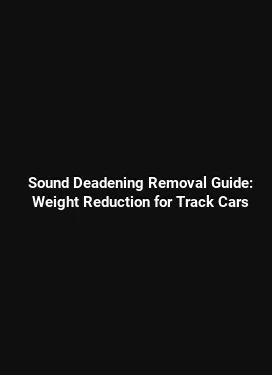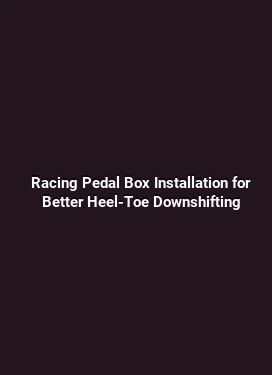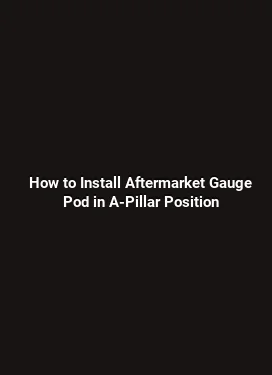Best Budget Racing Seats Under $600: Sparco vs Bride vs Recaro
Choosing the Right Budget Racing Seat for Your Car

In many performance-focused builds, the cockpit is where comfort, control, and safety converge. A well-chosen racing seat under six hundred dollars can transform driving feel, reduce fatigue on long sessions, and enhance driver confidence through improved positioning and side support. This analysis compares three well-known brands—Sparco, Bride, and Recaro—through the lens of interior aesthetics, safety features, material durability, and practical installation considerations. The emphasis is on practical guidance, comparing models that are commonly available at or near the $600 price point, and highlighting how to assess fit for a wide range of body types and driving styles.
The seating choice should account for chassis design, seat rails, mounting patterns, and occupant safety systems. A budget seat is not only about price; it is about achieving a balanced combination of support, visibility, and accessible adjustment to suit daily use or competitive events. The following sections explore these dimensions in depth, with concrete examples and actionable insights you can apply when browsing options online or at a retailer.
Key Factors: Fit, Comfort, and Safety

At the core of any racing seat decision is the fit to the driver. A seat that holds you firmly in a natural posture without restricting breathing or mobility contributes to precise handling and faster reaction times. Look for generous shoulder and torso support, a snug hip wrap, and a back angle that aligns with your steering wheel and pedal geometry. In budget models, foam density and contouring are critical indicators of long-term comfort, especially for drivers who spend extended sessions behind the wheel.
Materials matter as well. Automotive-grade fabric or vinyl with reinforced stitching tends to withstand wear from frequent ingress and egress, while a composite shell should provide a stable base for body weight without excessive flex. When evaluating safety, the seat’s compatibility with standard 4-point or 6-point harness systems, as well as its mounting footprint, should be considered. A well-designed seat will offer anchor positions that align with universal or vehicle-specific rail systems, ensuring secure installation without compromising seat travel or occupant safety devices.
Sparco: Balancing Value, Ergonomics, and Return on Investment
Sparco has earned a reputation for offering performance-oriented seating that blends ergonomic support with a broad range of fit profiles. In the under-$600 category, Sparco models often emphasize robust side bolsters, supportive lumbar regions, and a compact footprint suitable for smaller cabins as well as larger chassis designs. A prominent advantage is the balance between daily usability and track-ready restraint features, including compatibility with common harness configurations and secure mounting options.
In practice, Sparco seats at this price tier typically employ a multi-density foam core that maintains shape under repeated use and resists compression. The shell materials strike a compromise between rigidity and weight, delivering predictable feedback during aggressive cornering while staying within budget constraints. When selecting a Sparco model, consider the following: the seat’s maximum shoulder width and hip width to ensure comfortable seating for the majority of drivers, the availability of side mount rails that match standard seat patterns, and the ease of cleaning and maintenance for fabric or vinyl surfaces.
Practical Install Considerations for Sparco Models
Installation reliability rests on matching seat rails to the vehicle’s floor pan and ensuring the harness slots align with the chosen restraint system. For street-oriented builds, a reclining feature can be beneficial for comfort on longer drives; however, track-focused setups may prioritize fixed back angles to maximize lateral support. A common approach is to pair a Sparco seat with universal rails that offer multiple mounting positions, enabling adjustments to seat height and rake without interfering with pedals or steering column geometry. If your vehicle uses a side-mounted bucket seat, verify the clearance around the A-pillar and door opening to avoid interference during entry and exit.
Bride: Precision Craft, Comfort, and a Narrower Fit Profile
Bride seats are renowned for their precise craftsmanship and a reputation for a tighter, sportier fit. In the budget segment, Bride models tend to emphasize intimate shoulder and torso containment, which benefits drivers who prefer a snug, performance-oriented posture. This tight fit can be ideal for competitive drivers with a smaller frame or those who value maximal torso stabilization during aggressive maneuvers. The trade-off is potential fit challenges for broader physique profiles, so sizing and try-before-you-buy testing are crucial steps.
The materials and stitching in Bride seats generally reflect a commitment to durability under high-load conditions. Expect reinforced bolsters, careful seam construction, and a cover finish designed to resist wear from frequent ingress and egress. For enthusiasts seeking a Bride seat within the sub-$600 range, it’s important to assess lumbar support adjustability and whether the seat’s shell geometry allows for a comfortable range of recline without sacrificing lateral support.
Durability and Comfort Trade-Offs
Given Bride’s emphasis on a sportier silhouette, some models prioritize a firmer feel that translates to crisp feedback through the torso and thighs. The downside can be reduced long-distance comfort for drivers with broader hip measurements or longer upper bodies. To mitigate this, look for seats with a slightly more generous seat depth and a backrest that maintains support without pressing into the scapulae during extended sessions. Fabric or microfiber upholstery can also influence temperature regulation; consider materials that stay cooler in warm climates and resist fading with sun exposure in vehicles that receive substantial daylight.
Recaro: Known for Diversity of Fit and Reinforced Safety
Recaro’s lineup in the budget range often emphasizes a versatile set of fit profiles, with several models designed to accommodate a wider range of physiques. Recaro seats frequently incorporate a combination of performance geometry and comfort-focused cushions, balancing the need for secure lateral support with a more forgiving seating posture. A practical advantage is the availability of seats with standardized mounting patterns that align with common vehicle rails, which reduces installation complexity and helps ensure a solid, rattle-free installation.
In the under-$600 market, Recaro seats may emphasize features such as high-density foam, reinforced back shell construction, and durable fabrics that resist abrasion. For drivers prioritizing precise positioning, Recaro models can offer options with adjustable lumbar support through integrated foam inserts or subtle mechanical adjustments, complementing the seat’s contouring to reduce fatigue during long sessions or multi-hour track days.
Assessing Safety and Compatibility
Safety in a value-oriented Recaro seat hinges on compatibility with harness systems and crash-safe mounting points. Ensure the seat supports at least a two-point or five-point harness depending on your racing discipline, and verify the seat’s compatibility with your vehicle’s overall safety setup, including airbag considerations and immobilizer relevance in certain market configurations. A well-chosen Recaro seat will not only fit the body well but also allow secure anchoring with robust hardware, reducing movement during aggressive cornering or in the event of a collision.
When weighing Sparco, Bride, and Recaro within a budget ceiling, it is essential to align seat choice with driving goals and the vehicle’s ergonomics. A practical approach begins with precise body measurements, including shoulder width, hip width, torso length, and leg reach. Visualizing how your spine aligns with the seat’s backrest curvature helps anticipate pressure points that could cause discomfort. In addition, evaluating the seat’s mounting footprint—whether universal rails, side mounts, or a factory-compatible pattern—will influence installation ease and future resale value.
From a performance standpoint, the degree of lateral containment is a primary differentiator. A seat with pronounced side bolsters can improve posture stability during aggressive cornering but may feel restrictive for drivers with broader shoulders or a higher torso. Conversely, a seat with generous space inside the bucket can accommodate a wider range of drivers but might offer slightly less guidance during high-G maneuvers. It’s about finding the balance that matches your physique, driving style, and intended use—daily driving, weekend track days, or competitive racing.
Durability and material quality influence long-term satisfaction. A seat built with high-density foam tends to retain its supportive shape longer, reducing the likelihood of sagging in the lower back area. Fabric choices like performance-grade cloth or microfiber balance grip with breathability, while vinyl surfaces offer durability and ease of cleaning. Check stitching quality around attachment points and bolster seams to ensure resistance to wear after repeated entry and exit. For track use, consider abrasion resistance on the seat surface, as frequent harness strap contact can accelerate wear in shorter-nap fabrics.
Another practical aspect is heat management. Seats with breathable fabric or mesh panels can mitigate heat buildup during hot driving sessions, while fully sealed materials may trap heat. If you live in a hotter climate or often drive with the windows down at high speeds, a seat with a cooler surface can noticeably improve comfort and focus during long events.
Installing a budget racing seat involves aligning rails with the vehicle’s floor, ensuring proper clearance for pedals, steering, and door openings. Universal rails provide flexibility across many vehicles, but some applications benefit from vehicle-specific adapters that preserve proper wheel alignment and seating posture. Before purchasing, measure available headroom, shoulder clearance, and the space behind the seat for potential interference with seat belts or side-impact airbag systems if applicable in your market.
To optimize safety and performance, it is advisable to torque mounting bolts to manufacturer specifications, use locking nuts where appropriate, and inspect hardware after the first few hours of operation. Regular checks prevent loosening due to vibration and ensure your seating system maintains consistent alignment with steering and pedals. Consider adding seat spacers or tilt adjustments only if they do not compromise hull rigidity or harness geometry.
For a daily driver that doubles as a weekend racer, a seat with a moderate contour that supports the lumbar region and offers a few adjustment options can provide a comfortable compromise between track readiness and street usability. For smaller-framed drivers or those prioritizing aggressive seat feel, a Bride model with snug lateral support may be a perfect match, provided the fit is comfortable for long drives. For a broad range of drivers and a focus on a balanced performance, a versatile Recaro option that emphasizes fit diversity and robust mounting compatibility can deliver consistent results across different vehicle platforms.
In all cases, testing fit before committing to a purchase is ideal. If possible, request a test sit in the showroom, or measure and compare similar car seats already installed in your model to estimate the feel of the seat once mounted. Reviews from owners with similar builds can provide practical insights on comfort and durability that aren’t apparent from specifications alone.
Maintenance contributes to the longevity of racing seats under $600. Regular vacuuming to remove dust and debris from seams prevents fabric wear, while periodic conditioning of leather or leatherette surfaces helps prevent cracking in dry climates. For fabric seats, use a fabric-safe cleaner that does not leave residue, which could affect grip and comfort. Inspect the harness slots and belt guide areas for signs of wear and replace if fraying is detected. Finally, keep the seat’s upholstery clean from spilled oils or lubricants that can degrade fabric over time.
Create a practical shortlist by evaluating the following criteria: correct mounting pattern compatibility with your rails, adequate shoulder width and leg clearance, a backrest angle that aligns with your steering wheel height, and a comfort assessment based on a trial sit or validated user reviews. Confirm that the seat supports the type of harness you plan to use and that it can be installed without modifications that would void warranties or compromise safety systems. A structured comparison of model dimensions, materials, and warranty coverage helps prevent buyer’s remorse and ensures you invest in a seat that remains secure and comfortable across miles of driving and testing sessions.
Conclusion in Practice: Making an Informed Choice
Budget racing seats under six hundred dollars from Sparco, Bride, and Recaro offer a broad spectrum of fit profiles, materials, and installation options. The goal is to choose a seat that aligns with your body type, driving discipline, and vehicle geometry while maintaining a high standard of safety and durability. By focusing on fit, material quality, mounting compatibility, and practical maintenance, you can maximize performance benefits without exceeding the budget.






